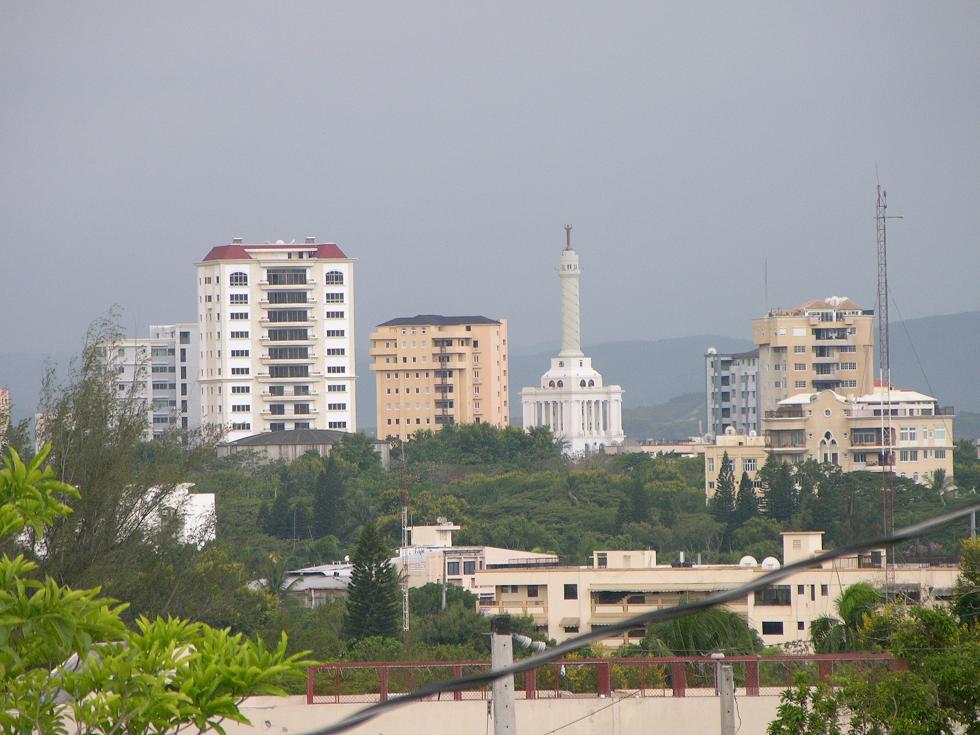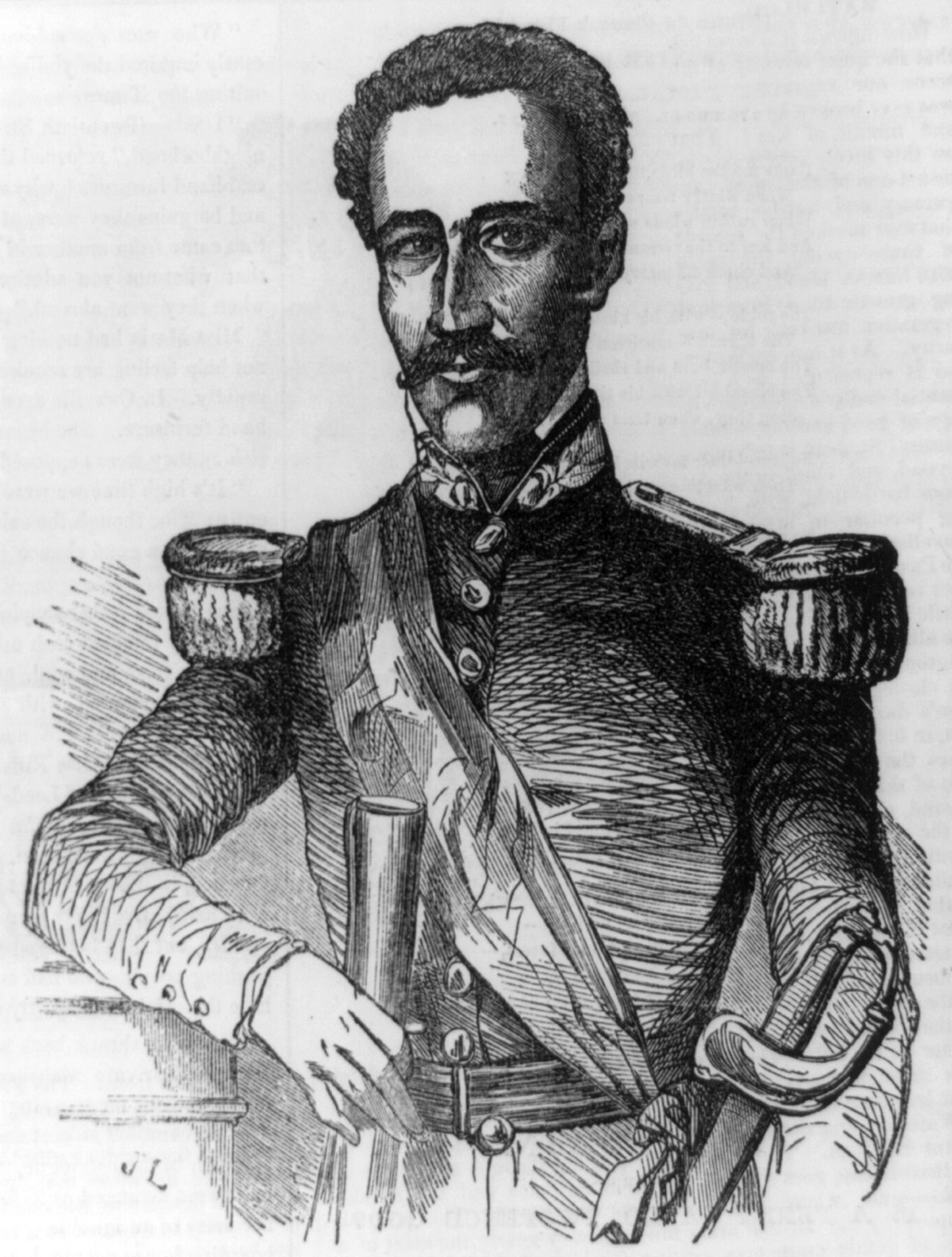|
Ulises Heureaux
Ulises Hilarión Heureaux Leibert (; October 21, 1845 – July 26, 1899) nicknamed Lilís, was president of the Dominican Republic from September 1, 1882 to September 1, 1884, from January 6, 1887 to February 27, 1889 and again from April 30, 1889 maintaining power between his terms until his assassination by Ramon Caceres. Early life Heureaux, known by the nickname of Lilís, was born in Puerto Plata. His father was José D’Assás Heureaux Fortune, who was born in Cap-Haïtien, Haiti, the son of Pierre Alexandre Heureaux, Judge of the Civil Court in Cap-Haïtien, and one of his household staff. Ulises's mother Josefa Leibert was born on the island Saint Thomas. His father was mulatto and his mother was African. Due to his cultural background, he was able to speak French and English in addition to Spanish fluently. Following the annexation of the Dominican Republic by Spain in 1861 he joined the rebellion to restore independence, becoming the principal lieutenant of Gen.& ... [...More Info...] [...Related Items...] OR: [Wikipedia] [Google] [Baidu] |
Coat Of Arms Of The Dominican Republic
The coat of arms of the Dominican Republic features a shield in similarly quartered colors as the flag, supported by a bay laurel branch (left) and a palm frond (right); above the shield, a blue ribbon displays the national motto: ''Dios, Patria, Libertad'' (God, Homeland, Liberty). Below the shield, the words ''República Dominicana'' appear on a red ribbon. In the center of the shield, flanked by six spears (three on each side), the front four holding the national flag, is a Bible which is open to John: 8:31–32 with a small golden cross above it. The coat of arms appears in the center of the flag of the Dominican Republic. Official description The constitution of the Dominican Republic describes the coat of arms as follows: ''The National Arms have the same colors as the National Flag arranged in the same manner. It has in the center a Bible open at the Gospel of Saint John, Chapter 8, Verse 32, and above it a cross, issuing from a trophy of two spears and four national f ... [...More Info...] [...Related Items...] OR: [Wikipedia] [Google] [Baidu] |
Santiago, Dominican Republic
Santiago de los Caballeros (; '' en, Saint James of the Knights''), often shortened to Santiago, is the second-largest city in the Dominican Republic and the fourth-largest city in the Caribbean by population. It is the capital of Santiago Province and the largest major metropolis in the Cibao region of the country, it is also the largest non-coastal metropolis in the Caribbean islands. The city has a total population of 1,173,015 inhabitants. Santiago is located approximately northwest of the capital Santo Domingo with an average altitude of 178 meters (584 ft). Founded in 1495 during the first wave of European settlement in the New World, the city is the "first Santiago of the Americas". Today it is one of the Dominican Republic's cultural, political, industrial and financial centers. Due to its location in the fertile Cibao Valley it has a robust agricultural sector and is a leading exporter of rum, textiles, and cigars. Santiago is known as "La Ciudad Corazón" (the " ... [...More Info...] [...Related Items...] OR: [Wikipedia] [Google] [Baidu] |
Ozama River
The Ozama River () is a river in the Dominican Republic. It rises in the Loma Siete Cabezas mountain in the Sierra de Yamasá mountain range, close to the town of Villa Altagracia. History In 1498, Bartolome Colon had a fort built on the Ozama River delta, which would later become the first permanent European settlement in the New World (Santo Domingo). The estuary at that time, "teemed with fish and where the Indians raised cassava and yams," according to Floyd. Course The river flows before emptying into the Caribbean Sea. At the end of the journey it bisects the capital, Santo Domingo, into eastern and western halves. The three main tributaries of the Ozama are the Isabela River, the Sabita River and the Yabacao River. The Ozama's basin is the fourth largest in the Dominican Republic. The river has several tributaries, with a combined area of . The river basin has an annual precipitation of to per year. Pollution The Ozama River is heavily polluted. It is constantly a ... [...More Info...] [...Related Items...] OR: [Wikipedia] [Google] [Baidu] |
Ten Years' War
The Ten Years' War ( es, Guerra de los Diez Años; 1868–1878), also known as the Great War () and the War of '68, was part of Cuba's fight for independence from Spain. The uprising was led by Cuban-born planters and other wealthy natives. On 10 October 1868, sugar mill owner Carlos Manuel de Céspedes and his followers proclaimed independence, beginning the conflict. This was the first of three liberation wars that Cuba fought against Spain, the other two being the Little War (1879–1880) and the Cuban War of Independence (1895–1898). The final three months of the last conflict escalated with United States involvement, leading to the Spanish–American War. Background Slavery Cuban business owners demanded fundamental social and economic reforms from Spain, which ruled the colony. Lax enforcement of the slave trade ban had resulted in a dramatic increase in imports of Africans, estimated at 90,000 slaves from 1856 to 1860. This occurred despite a strong abolitionist m ... [...More Info...] [...Related Items...] OR: [Wikipedia] [Google] [Baidu] |
Cibao Valley
The Cibao, usually referred as "El Cibao", is a region of the Dominican Republic located at the northern part of the country. As of 2009 the Cibao has a population of 5,622,378 making it the most populous region in the country. The region constitutes a "developed macro-region"; with a large industrial base and high levels of progress among its inhabitants, it has the highest levels of education and the highest quality of life among the three main regions of the Dominican Republic. Cibao is social-culturally characterized by the overwhelming predominance of the European legacy in the island, and economically for being the most prosperous region in the country. Etymology The word Cibao, ; , means "place where rocks abound". Cibao was a native name for the island, although the Spanish used it during the Spanish conquest to refer to the rich and fertile valley between the Central and Septentrional mountain ranges. Geography and economy El Cibao occupies the central and northern par ... [...More Info...] [...Related Items...] OR: [Wikipedia] [Google] [Baidu] |
Cacique
A ''cacique'' (Latin American ; ; feminine form: ''cacica'') was a tribal chieftain of the Taíno people, the indigenous inhabitants at European contact of the Bahamas, the Greater Antilles, and the northern Lesser Antilles. The term is a Spanish transliteration of the Taíno word ''kasike''. Cacique was initially translated as "king" or "prince" for the Spanish. In the colonial era the conquistadors and the administrators who followed them used the word generically, to refer to any leader of practically any indigenous group they encountered in the Western Hemisphere. In Hispanic and Lusophone countries, the term also has come to mean a political boss, similar to ''caudillo,'' exercising power in a system of ''caciquismo''. Spanish colonial-era caciques The Taíno word ''kasike'' descends from the Taíno word ''kassiquan'', which means "to keep house". In 1555 the word first entered the English language, defined as "prince". In Taíno culture, the ''kasike'' rank was her ... [...More Info...] [...Related Items...] OR: [Wikipedia] [Google] [Baidu] |
Santo Domingo
, total_type = Total , population_density_km2 = auto , timezone = AST (UTC −4) , area_code_type = Area codes , area_code = 809, 829, 849 , postal_code_type = Postal codes , postal_code = 10100–10699 (Distrito Nacional) , website Ayuntamiento del Distrito Nacional Santo Domingo ( meaning "Saint Dominic"), once known as Santo Domingo de Guzmán and Ciudad Trujillo, is the capital and largest city of the Dominican Republic and the largest metropolitan area in the Caribbean by population. As of 2022, the city and immediate surrounding area (the Distrito Nacional) had a population of 1,484,789, while the total population is 2,995,211 when including Greater Santo Domingo (the "metropolitan area"). The city is coterminous with the boundaries of the Distrito Nacional ("D.N.", "National District"), itself bordered on three sides by Santo Domingo Province. Founded by the Spanish in 1496, on the east bank of the Ozama River and then moved by Nicolás de Ovando in 1502 ... [...More Info...] [...Related Items...] OR: [Wikipedia] [Google] [Baidu] |
Buenaventura Báez
Ramón Buenaventura Báez Méndez (July 14, 1812March 14, 1884), was a Dominican politician and military figure. He was president of the Dominican Republic for five nonconsecutive terms. His rule was characterized by being very corrupt and governing for the benefit of his personal fortune. Genealogical studies have identified Buenaventura Báez as one of the fathers of the modern Dominican oligarchy, with many of his descendants dominating the political and economic life of the Dominican Republic today. He fathered several children, nine of which he recognized, while some were born in the Dominican Republic, others were born in Puerto Rico and France. Early years and family Báez was born in Cabral, Barahona, Rincón (now Cabral) in the Captaincy General of Santo Domingo, he was raised in his father's hometown Azua. Báez was the son of Pablo Altagracia Báez and Teresa de Jesús Méndez. His father Pablo, a wealthy merchant from Azua Province, Azua, was left in an orphanage ... [...More Info...] [...Related Items...] OR: [Wikipedia] [Google] [Baidu] |
Ulises Espaillat
Ulises Francisco Espaillat Quiñones (February 9, 1823 – April 25, 1878) was a Dominican author and politician. He served as president of the Dominican Republic from April 29, 1876 to October 5, 1876. Espaillat Province is named after him. Early life Ulises Francisco Espaillat Quiñones was born on 9 February 1823 in Santiago, officially known from 1822 to 1844 as ''Saint-Yague'', into a wealthy family of French, Canarian, Aragonese and Genovese descent; he was the only son of Pedro Ramón Espaillat Velilla (Santiago, 1796−idem, 1882) and María Petronila Quiñones Tavares (1804−1874). His father was the tenth and junior child of Francisco Espaillat y Virol —a Frenchman native to Masclat that settled in Santiago in 1758 in an epoch where one-third of the population was of French origin— and Petronila Velilla Sánchez —whose father was born in Aragon. He was described by his contemporaries as a tall, pale-complexioned, blue-eyed, dark blond-haired man. In ... [...More Info...] [...Related Items...] OR: [Wikipedia] [Google] [Baidu] |
Gregorio Luperón
Gregorio Luperón (September 8, 1839 – May 21, 1897) was a Dominican president, military general, businessman, liberal politician, freemason, and Statesman who was one of the leaders in the Restoration of the Dominican Republic after the Spanish annexation in 1863. Luperón was an active member of the Triunvirato of 1866, becoming the President of the Provincial Government in San Felipe de Puerto Plata, and after the successful coup against Cesareo Guillermo, he became the 28th President of the Dominican Republic. During his government in 1879, he incentivised secularism in the Dominican Republic with the help of the General Captain of Puerto Rico and Eugenio María de Hostos. Biography Gregorio Luperón was born 8 September 1839 in Puerto Plata to Pedro Castellanos, a Dominican of Spanish descent, and Nicolasa du Perron (the surname du Perron would later become "Luperón", to sound more Spanish), a black immigrant from the Lesser Antilles. His parents owned a ''ventorril ... [...More Info...] [...Related Items...] OR: [Wikipedia] [Google] [Baidu] |







